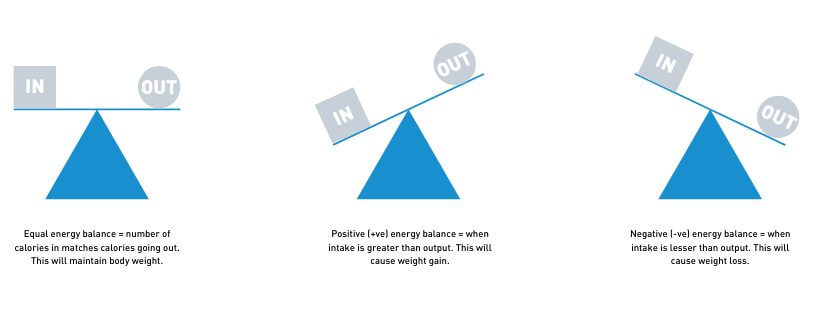

As we are now in isolation, matching your diet and level of activity is more important than ever. Due to the quarantine and lockdown, your opportunities to exercise may be limited. Therefore, your nutrition should match the level of activity you are doing.
In times of inactivity, you want to be eating for maintenance.
First, we need briefly look at energy balance. Below I will illustrate positive (+ve), negative (-ve) and equal energy balance.

Well, that depends. If you want to lose weight, going on a calorie deficit (between 300-500kcal) per day would be a good start, i.e for average men and women in the UK, consuming 2500 and 2000kcal would be enough to maintain weight respectively. So if you want to lose weight, dropping your calorie allowance at 2000 and 1500kcal respectively would be a good start. I personally wouldn’t recommend going below 1000kcal as this could impede metabolic function, cause fat mass and fat free mass (lean body tissue i.e. muscle).
To know how much you should consume, use a calculator (however these calculators online are based on your subjective input i.e. level of activity, so still an estimate).
Total daily energy expenditure (TDEE) will determine how many calories you are advised to consume to maintain, lose and gain weight. TDEE is calculated using resting energy expenditure (BMR = 70% of total TDEE) and NREE (non-resting energy expenditure i.e. exercise, non-exercise activity thermogenesis a.k.a. NEAT, thermic effect of food or TEF for short).
Personally, I would not recommend to view the exercise calories (the amount you burnt) as calories earned to eat more as this may get you into bad habits, especially if your goal is weight loss. This is because when you exercise, your body gets used to the type of training you do, hence the amount of calories you burn becomes less and less over time.
With fitness trackers, even though they are getting better with technology, they still have their limitations i.e. only goes on one side of your body and only on one limb, you often rest between sets of resistance training and the fitness tracker may still record that calories being burnt. In short, fitness trackers may overshoot the amount of calories you burn so if the tracker said you burnt 500 kcals in weight training but realistically you only burn 200 (due to long rest times), then you may have eaten more calories than you thought you could.
Therefore, my advice is to use a calculator and stick with it for the next week! You can use apps such as My Fitness Pal to log all food intake (when first setting up, it will ask you how much to lose etc, ignore that for now and continue set up. You may still have to put in your goals etc so I recommend putting in 0.5kg loss a week etc but the numbers will be different from the calculator and My Fitness Pal. This is because the calorie allowance will be dictated on how much you want to lose. As recommended, losing 0.5kg per week would be the safe margin).
If you’re not sure about portion sizing, I recommend reading the Find Your Balance article by the British Nutrition Foundation.
To find out more about how much of each food you should be consuming, I recommend reading the NHS guidelines to make sure you get a balanced and varied diet!
Aaron Manio
Registered Associate Nutritionist AfN
Personal Trainer